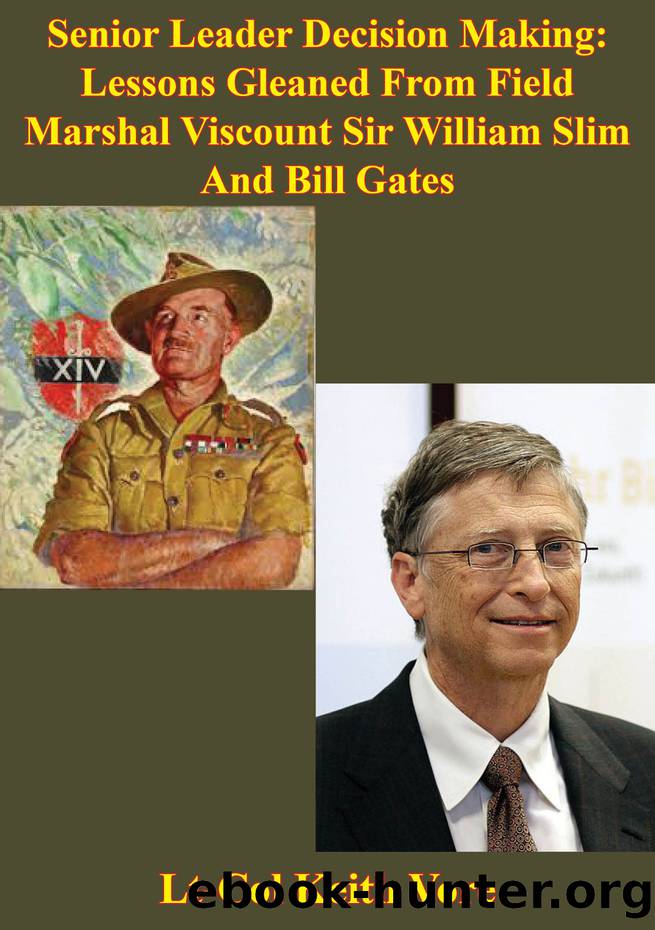Senior Leader Decision Making: Lessons Gleaned From Field Marshal Viscount Sir William Slim And Bill Gates by Vore Lt-Col Keith;

Author:Vore, Lt-Col Keith;
Language: eng
Format: epub
Publisher: Verdun Press
Published: 2014-07-30T00:00:00+00:00
ANALYSIS AND SUMMARY
Sir William Slimâs actions in the overall Burma campaign reflected his tendency to use patterns and anomalies to help him understand what was happening. However, his ability to do so depended directly on his ability to have the intelligence required to help form those impressions, something which he was unable to rely upon during the 1942 retreat. But just as importantly, his continued exposure to the Japanese so increased his experience that he was able to increasingly discern Japanese patterns and anomalies as operations progressed through 1944 and into 1945. His six page analysis of the Japanese intentions in the post-Imphal time period, relative to the limited references of his thinking about the Japanese earlier, directly reflects the confidence that he had steadily acquired up to that point. One must have significant experience, as well as the ability to exercise situational awareness, in order to use patterns and anomalies safely. Without that experience, one uses patterns and anomalies at oneâs risk.
Slim did not rely on Kleinâs notion of singular evaluation, however. He resorted instead to options generation, thinking through several courses of action before settling on the preferred course.
He showed a tremendous willingness to use leverage points in all aspects of his operations. When considering his entire kit bag of leverage points, however, one is struck by the fact that Slim did not simply identify existing leverage pointsâthings which existed that the Japanese could also have taken advantage of (a key terrain feature, for example). Slim upped the ante with several of his leverage points, like road and riverboat construction in a most inventive way: he created them. It is certainly one thing to be able to identify the leverage points in an existing âsystem,â and to operate off of those leverage points, in zero-sum game fashion, in a way that leverages a relative advantage over an opponent. It is another thing entirely to add leverage points creatively to that system, breaking the bond of the zero-sum game. This point is most important for those who aspire to operate according to Gary Kleinâs theories.
Two other aspects of Sir William Slim are worth mentioning at this point. They have to do with his method of planning operations, and his work ethic. U.S. Army Field Manual 101-5, Staff Organization and Operations, in conjunction with Field Manual 134-130, Intelligence Preparation of the Battlefield, intimate that U.S. Army commanders and staff planners, in considering how to operate against an enemy force, consider what the enemyâs possible options are against the friendly force, before devising options to counter that enemy force. This planning framework is decidedly reactive. Rather than impose operations upon the enemy, this theoretical framework ensures that U.S. Army commanders and planners view everything from the enemyâs perspective first. That is not to suggest that the enemyâs perspective is unimportantâit is not. Rather, the friendly force commander or planner should proceed in a manner which allows him to consider first what he wants to do to the enemy, and then to consider how the enemyâs options might frustrate those intentions.
Download
This site does not store any files on its server. We only index and link to content provided by other sites. Please contact the content providers to delete copyright contents if any and email us, we'll remove relevant links or contents immediately.
| Central Asia | Southeast Asia |
| China | Hong Kong |
| India | Japan |
| Korea | Pakistan |
| Philippines | Russia |
The Rape of Nanking by Iris Chang(3518)
The Sympathizer by Viet Thanh Nguyen(3487)
World without end by Ken Follett(3008)
Ants Among Elephants by Sujatha Gidla(2925)
Blood and Sand by Alex Von Tunzelmann(2610)
Japanese Design by Patricia J. Graham(2557)
City of Djinns: a year in Delhi by William Dalrymple(2137)
Inglorious Empire by Shashi Tharoor(2102)
Foreign Devils on the Silk Road: The Search for the Lost Treasures of Central Asia by Peter Hopkirk(2056)
In Order to Live: A North Korean Girl's Journey to Freedom by Yeonmi Park(2055)
Tokyo by Rob Goss(2018)
India's Ancient Past by R.S. Sharma(1988)
India's biggest cover-up by Dhar Anuj(1985)
The Great Game: On Secret Service in High Asia by Peter Hopkirk(1962)
Tokyo Geek's Guide: Manga, Anime, Gaming, Cosplay, Toys, Idols & More - The Ultimate Guide to Japan's Otaku Culture by Simone Gianni(1947)
Goodbye Madame Butterfly(1937)
The Queen of Nothing by Holly Black(1757)
Living Silence in Burma by Christina Fink(1731)
Batik by Rudolf Smend(1721)
